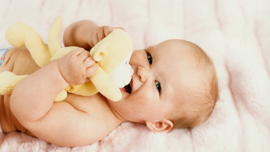8 toys every preschooler should have
While they still play with some of their old toddler toys, preschoolers are ready to play in more sophisticated ways. Here are a few playthings every preschooler should have.

Preschoolers will loudly proclaim they are "big kids" as they climb on your lap to cuddle. They still have some baby social needs but are ready to take on some big kid roles. In a year or two, they need to be ready for kindergarten, too! Preschoolers will still play with many of their toddler toys (in fact, when I brought the toddler music table out for my baby, he had to take turns with the 4- and 6-year-olds). As preschoolers, though, they play in a more sophisticated way. Here are a few playthings you can add to their toy chests to help them explore their new skills and interests:
- Fashion dolls and action figures: These toys say "3+" on the packaging for good reason. By age 3, most children have stopped mouthing their toys, making these smaller parts safe for preschoolers. Preschoolers have also gained the fine motor control to dress dolls and manipulate small accessories on some toys without frustration. Preschoolers will use figurines to re-play their days, just like older toddlers, but they will also increasingly engage in imaginative fantasy play. Finally able to conceive of something beyond their own existence, preschoolers will want to pretend their figurines are teachers or firefighters or even brave dragon-slayers and wise queens. These figurines and dolls are also a perfect opportunity to talk about weather-appropriate dressing with preschoolers who are starting to pick out their own outfits.
- Tools: Growing manual dexterity allows preschoolers to play with toy wrenches that actually turn bolts or use safety scissors to cut fun dough or paper. Keep buckets of age-appropriate crafting and construction tools and let your child create and build. Not only is he developing that fine motor control he'll need in school, he is also gaining a sense of accomplishment by making something on his own.
- Melodic musical toys: Even older infants enjoy musical toys and preschoolers are ready to move onto melodies. Preschoolers not only recognize their favorite tunes, they are increasingly able to sing them back to you. Allow your child to explore music with toys like the Xylophone Zoo and the Poppin' Play Piano. Who knows, you might even have a future Mozart!
- Dress-up clothing and props: As preschoolers develop more vivid imaginations, their dramatic play will become richer. There are lots of commercial dress-up clothes but kids will happily turn old hats into helmets, a scarf into a mermaid's tale, an old suit jacket into a prince's cloak, and costume jewelry into pirate treasure. Supply them with plenty of clothing and props so they can transform their playroom into a whole new world of adventure.
- Writing toys: In preparation for the reading, writing and arithmetic they'll do in kindergarten and elementary school, preschoolers may be ready to start practicing writing numbers and letters. My kids love the Scribble & Write and now LeapFrog also has the Count & Draw. The LeapPad also comes standard with a program that allows kids to practice writing with the stylus and get instant feedback on their neatness and accuracy. In addition to tech writing toys, my kids also enjoy dry-erase writing and "magic" water pen writing—anything that makes writing fun and special!
- Bikes and trikes: Your big kid is ready for some big(ger) wheels! While we're practicing fine motor skills, don't forget about the gross motor development that will help kids stay fit...and have fun outdoors!
- Maps and charts and diagrams: Your child's growing awareness of the world around him makes this a perfect time to introduce maps. Find out where grandma went on vacation, locate places in favorite stories, and even explore outer space. With the new common core standards in place in most states, give your child an early start on reading and processing visual information.
- A ton of books! Reading to your child is always important and it is absolutely critical at the preschool age. Your child is developing pre-literacy skills galore, including improved letter recognition and phonics. Older preschoolers will be ready to move from the Tag Junior to the LeapReader to practice reading longer stories and more complex comprehension games.










